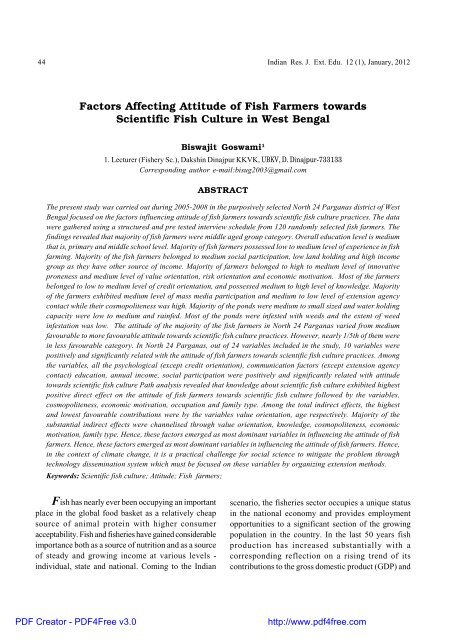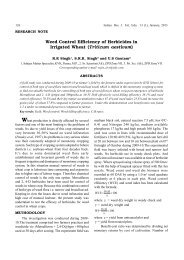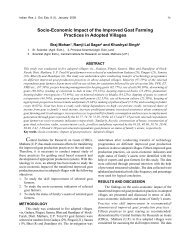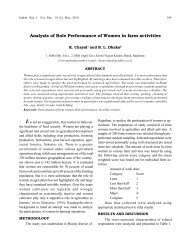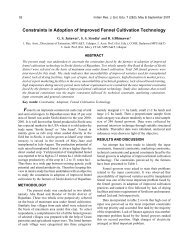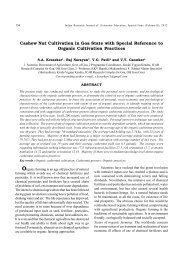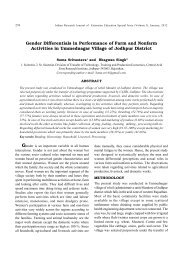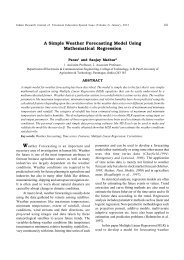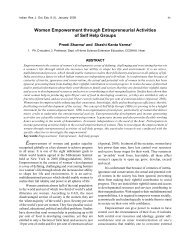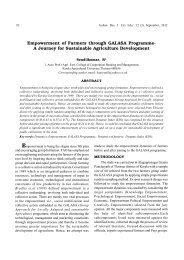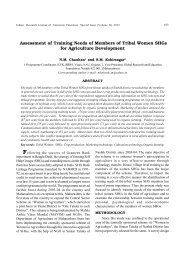Factors Affecting Attitude of Fish Farmers towards ... - Seea.org.in
Factors Affecting Attitude of Fish Farmers towards ... - Seea.org.in
Factors Affecting Attitude of Fish Farmers towards ... - Seea.org.in
Create successful ePaper yourself
Turn your PDF publications into a flip-book with our unique Google optimized e-Paper software.
48 Indian Res. J. Ext. Edu. 12 (1), January, 2012farmers and significant contribution to the variation wasattributed to variables viz., caste, family size, annual<strong>in</strong>come, cosmopoliteness, <strong>in</strong>novative proneness,knowledge and size <strong>of</strong> the water body.Path analysis (Table 3) revealed that knowledgeabout scientificfishcultureexhibitedhighestpositivedirecteffect on the attitude <strong>of</strong> fish farmers <strong>towards</strong> scientificfish culture followed by the variables, cosmopoliteness,economic motivation, occupation and family type. Amongthe total <strong>in</strong>direct effects, the highest and lowest favourablecontributions were by the variables value orientation, agerespectively. Majority <strong>of</strong> the substantial <strong>in</strong>direct effectswere channelised through value orientation, knowledge,cosmopoliteness, economic motivation, family type.Table 3. Path coefficient show<strong>in</strong>g direct, <strong>in</strong>direct and substantial <strong>in</strong>direct effects <strong>of</strong> <strong>in</strong>dependentvariables on attitude <strong>of</strong> fish farmers <strong>towards</strong> scientific fish culture practicesCorrelation Direct Total Variables through which substantialSN Variables coefficient effects Rank <strong>in</strong>direct Rank <strong>in</strong>direct effects are channeled througheffect I II IIIX1 Age -0.150 0.062 11 -0.212 23 0.085(X20) 0.077(X3) 0.065(X4)X2 Caste -0.170 -0.097 17 -0.073 19 0.105(X7) 0.093(X14) 0.047(X17)X3 Family size 0.130 0.228 6 -0.098 20 0.149(X4) 0.066(X19) 0.048(X21)X4 Family type 0.140 0.272 5 -0.132 21 0.125(X3) 0.058(X8) 0.057(X17)X5 Education 0.180 0.110 9 0.070 12 0.154(X14) 0.141(X20) 0.101(X17)X6 <strong>Fish</strong> farm<strong>in</strong>g experience 0.100 -0.165 19 0.265 8 0.121(X20) 0.098(X17) 0.078(X19)X7 Occupation 0.140 0.291 4 -0.151 22 0.082(X21) 0.077(X6) 0.070(X20)X8 Annual <strong>in</strong>come 0.350 0.205 7 0.145 10 0.171(X20) 0.170(X21) 0.168(X17)X9 Size <strong>of</strong> land hold<strong>in</strong>g 0.150 0.153 8 -0.003 17 0.197(X21) 0.161(X20) 0.141(X17)X10 Social participation 0.350 -0.123 18 0.473 2 0.216(X20) 0.187(X14) 0.148(X17)X12 Mass media 0.330 0.029 13 0.301 6 0.271(X20) 0.187(X14) 0.161(X17)participationX13 Extension agency 0.150 -0.201 21 0.351 5 0.215(X14) 0.171(X20) 0.124(X17)contactX14 Cosmopoliteness 0.480 0.467 2 0.013 15 0.286(X20) 0.222(X17) 0.161(X19)X15 Innovative 0.420 0.002 14 0.418 3 0.224(X14) 0.211(X20) 0.128(X19)pronenessX16 Credit orientation -0.020 -0.032 15 0.012 16 0.067(X17) 0.060(X19) 0.057(X4)X17 Value orientation 0.330 -0.336 22 0.666 1 0.308(X14) 0.301(X20) 0.209(X19)X18 Risk orientation 0.240 -0.174 20 0.414 4 0.233(X14) 0.226(X20) 0.197(X19)X19 Economic motivation 0.320 0.299 3 0.021 13 0.252(X14) 0.246(X20) 0.235(X17)X20 Knowledge 0.620 0.502 1 0.118 11 0.266(X14) 0.202(X17) 0.146(X19)X21 Size <strong>of</strong> water body -0.040 -0.340 23 0.300 7 0.155(X17) 0.146(X19) 0.103(X8)X22 Duration <strong>of</strong> water 0.010 0.037 12 -0.027 18 0.170(X21) 0.094(X17) 0.093(X3)availabilityX23 Source <strong>of</strong> water 0.090 0.073 10 0.017 14 0.055(X20) 0.043(X4) 0.039(X8)X24 Extent <strong>of</strong> weed 0.160 -0.094 16 0.254 9 0.122(X4) 0.072(X8) 0.061(X7)<strong>in</strong>festationResidual effect : 0.604Hence, these factors emerged as most dom<strong>in</strong>ant variables<strong>in</strong> <strong>in</strong>fluenc<strong>in</strong>g the attitude <strong>of</strong> fish farmers.Knowledge, value orientation, cosmopoliteness,economic motivation, family type, <strong>in</strong>novative proneness,annual <strong>in</strong>come, family size and size <strong>of</strong> water body playan important role <strong>in</strong> develop<strong>in</strong>g the attitude <strong>of</strong> therespondents <strong>towards</strong> scientific fish culture practices.Hence, these factors emerged as most dom<strong>in</strong>ant variables<strong>in</strong> <strong>in</strong>fluenc<strong>in</strong>g the attitude <strong>of</strong> fish farmers. Any positivechange <strong>in</strong> these variables would lead to the development<strong>of</strong> favourable attitude amongst the fish farmers. Theseresults are <strong>in</strong> strongly corroboratedby the f<strong>in</strong>d<strong>in</strong>gs <strong>of</strong> step wise multiple regressionanalysis.PDF Creator - PDF4Free v3.0http://www.pdf4free.com
Indian Res. J. Ext. Edu. 12 (1), January, 2012 49CONCLUSIONThe study revealed that majority <strong>of</strong> the fish farmerspossessed medium favourable attitude to morefavourable attitude <strong>towards</strong> scientific fish culturepractices. Knowledge, value orientation,cosmopoliteness, economic motivation, family type,<strong>in</strong>novative proneness, annual <strong>in</strong>come, family size andsize <strong>of</strong> water body reflected the strong association andeffect with the attitude and these factors emerged asmost dom<strong>in</strong>ant variables <strong>in</strong> <strong>in</strong>fluenc<strong>in</strong>g the attitude <strong>of</strong>fish farmers. Based on the above f<strong>in</strong>d<strong>in</strong>gs the studyrecommends the follow<strong>in</strong>g to br<strong>in</strong>g about change <strong>in</strong> theattitude <strong>of</strong> fish farmers <strong>in</strong> order to promote large scaleadoption <strong>of</strong> scientific fish culture to <strong>in</strong>crease fishproduction as well as their socio economic conditions.• Make adequate use <strong>of</strong> various teach<strong>in</strong>g methodseffectively like demonstration, field day, On-farmtest<strong>in</strong>g, exhibition, film show, educational tour,campaigns, farm cl<strong>in</strong>ic, sem<strong>in</strong>ar, workshop and<strong>in</strong>formation communication technology like radio,TV, different audio visual aids and <strong>in</strong>ternet, etc.for rais<strong>in</strong>g the level <strong>of</strong> knowledge on differentaspects <strong>of</strong> scientific fish culture together withmarket<strong>in</strong>g and cultural practices.• Economic benefits <strong>of</strong> scientific culture need tobe vividly focused to change attitude <strong>of</strong> the fishfarmers to adopt scientific fish culture practices.• Cosmopolite methods like exposure visits, studytours etc need to be <strong>org</strong>anized by the concernedextension agency.• More number <strong>of</strong> younger fish farmers need to beencouraged <strong>in</strong> tra<strong>in</strong><strong>in</strong>g on scientific fish culturepractices.• It is urgently needed to recognize and reorientthe fishery extension system with limitedresources and scarce extension staff to providetechnical and <strong>in</strong>put support to the farmers toenhance knowledge, positive attitude andadoption level through adm<strong>in</strong>istrative and policymeasures.• It is necessary to formulat<strong>in</strong>g and monitor<strong>in</strong>g <strong>of</strong>visit schedule <strong>of</strong> extension <strong>of</strong>ficial with creation<strong>of</strong> monitor<strong>in</strong>g and evaluation cell at apex level bythe decision makers.Paper received on : October 26, 2010Received after revision : June 07, 2011Accepted on : September 13, 2011REFERANCES1. Awasthi, H.K., S<strong>in</strong>gh, P.R. and Sharma, R.N. (2000). Knowledge and attitude <strong>of</strong> dairy farmers <strong>towards</strong> improved dairypractices. Mah. J. Ext. Edu. 19 : 290-292.2. Arivand, N. (1999). Homestead Agro-forestry system <strong>in</strong> Kerala – <strong>Farmers</strong> perception and attitude, M.Sc. thesis (Unpub.),U.A.S., Bangalore.3. Balasubramaniam, S. (1988). Analysis <strong>of</strong> technology transfer effectiveness <strong>in</strong> <strong>in</strong>land fish farm<strong>in</strong>g. Ph.D. thesis (unpub.),TNAU, Coimbatore.4. Balasubramaniam, S., Bihari, B and Mohan, B.( 2001). Socio-economic status <strong>of</strong> mar<strong>in</strong>e fishermen <strong>in</strong> two fish<strong>in</strong>g villages<strong>of</strong> Orissa. <strong>Fish</strong>ery Technology., 38 (1) : 51-55.5. Basavakumar, K.V. and Yaligar, D.M. (2000). Impact <strong>of</strong> tra<strong>in</strong><strong>in</strong>g on the knowledge and op<strong>in</strong>ion <strong>of</strong> tra<strong>in</strong>ees on brackishwater prawn farm<strong>in</strong>g. Karnataka J. Agril. Sci. 13 (3) : 707-711.6. Dana, S.S. (1987). A study <strong>of</strong> factors affect<strong>in</strong>g the attitude <strong>of</strong> livestock-owners <strong>towards</strong> artificial <strong>in</strong>sem<strong>in</strong>ation <strong>in</strong> cattle.M.V.Sc. thesis (Unpub.), IVRI,Izatnagar,U.P.7. Dixit, S. (1988). A study on the impact <strong>of</strong> social forestry programme on rural beneficiaries, M.Sc. (Ag.) thesis (Unpub.),U.A.S., Bangalore.8. Haque, M.A. (1989). Composite fish farm<strong>in</strong>g technology for rural development. In : Ray, G.L. (Ed.), AgriculturalTechnologies for Rural development, Vikas Publish<strong>in</strong>g House Pvt. Ltd., New Delhi.9. Mahandra Kumar K. (1996). Communication behviour <strong>of</strong> fish farmers <strong>in</strong> Tamil Nadu, Ph.D. thesis (unpub.), CIFE, Mumbai.10. Nagarajaiah, C.S. (2002). A study on knowledge attitude and extent <strong>of</strong> adoption <strong>of</strong> composite fish culture practices <strong>in</strong>south Karnataka. Ph.D. thesis (Unpub). Central Institute <strong>of</strong> <strong>Fish</strong>eries Education, Versova, Mumbai-400061.11. Natarajan, K. and Muthaiah, M. (1995). <strong>Attitude</strong> <strong>of</strong> farmers <strong>towards</strong> social forestry programme.J. Ext. Edu., 6 (1) : 1089-1090.12. Nijagonda, H. (2000). A study on attitude, communication and market<strong>in</strong>g pattern <strong>of</strong> red gram growers <strong>in</strong> Bidar district,M.Sc. (Ag.) thesis (Unpub.), U.A.S., Bangalore.PDF Creator - PDF4Free v3.0http://www.pdf4free.com
50 Indian Res. J. Ext. Edu. 12 (1), January, 201213. Perumal, G., Ponnappan, C. and Balasubramaniam, S. 1988. <strong>Attitude</strong> <strong>of</strong> fish farmers <strong>towards</strong> <strong>Fish</strong> <strong>Farmers</strong>Development Agency (FFDA), Rural Development Reviews, TNAU, 7 : 667-668.14. Ponnappan, C. (1982). <strong>Fish</strong> <strong>Farmers</strong> Development Agency Programme : An analysis. M.Sc. (Ag.) thesis (Unpub.),TNAU, Coimbatore.15. Prasad, M.S. (1995). Adoption <strong>of</strong> dry land agriculture technologies by farmers <strong>of</strong> Ranga Reddy district (AP). ARetrospective Analysis, Ph.D. thesis, U.A.S., Dharwad.16. Raju Naik, H., Sundara Swamy, B. and Ansaraj, M.R. (1994). <strong>Attitude</strong> <strong>of</strong> farmers <strong>towards</strong> seed supply<strong>in</strong>g agencies as<strong>in</strong>fluenced by their personal and socio-economic characteristics. Mah. J. Ext. Edu.. 13 : 183-186.17. Roy, L. and Pathak, M. (2000). <strong>Attitude</strong> <strong>of</strong> farm women <strong>towards</strong> post harvest activities. Indian J. Ext. Edu.36 (1&2) : 82-84.18. Siddaramaiah, B.S. and Reddy, H.C.V. (1993). <strong>Attitude</strong> and adoption behaviour <strong>of</strong> farmers <strong>towards</strong> watershed management.Mysore J. Agri. Sci. 27 (3) : 291-296.19. Sidhu, K.S. (1980). A study <strong>of</strong> dimensional variation <strong>in</strong> the knowledge <strong>of</strong> dairy farmers <strong>of</strong> I.C.D.P. and non-I.C.D.P. area<strong>of</strong> Punjab. M.Sc. thesis (unpub.), Kurukshetra University, Kurukshetra.20. Supe, S.V. (2002). Introduction to Extension Education. 4th edu. Chapter 2nd, Oxford & IBH Publish<strong>in</strong>g Co. Pvt. Ltd.,New Delhi.21. Surekha, S., Pemalatha, B. and Nagaraja, N. (1997). <strong>Attitude</strong> <strong>of</strong> farmers <strong>towards</strong> watershed development.Mah. J. Ext. Edu., 16 : 82-85.22. Talukdar, P.K. (2000). Knowledge level and extent <strong>of</strong> adoption <strong>of</strong> composite fish culture practices byaquaculturists <strong>in</strong> Sonitpur district <strong>of</strong> Assam. M.F.Sc. thesis (unpub.), CIFE, Mumbai.******PDF Creator - PDF4Free v3.0http://www.pdf4free.com


